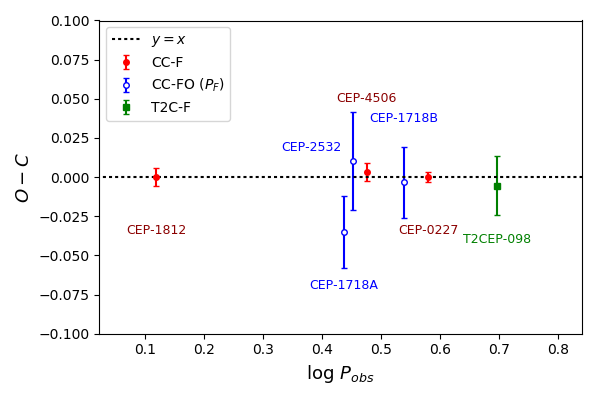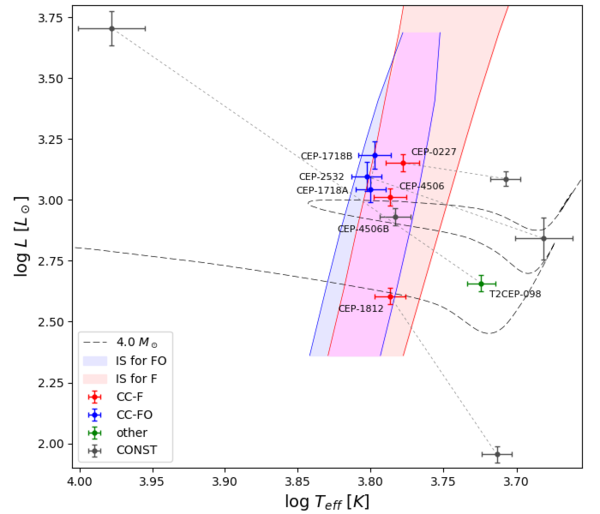 |
Catalogs
Cepheid Phys. Properties
Binary Cepheid Solutions
Projects
SB2 Cepheids
Classical Cepheids
Type II Cepheids
Papers
by category
by first author
by target
Visitors so far: 87800.
The analysis of classical Cepheids in eclipsing binary systems give as opportunity to learn about the physical parameters of these very important objects, which are crucial for our understanding of the theory of evolution and theory of pulsation, and are ones of the most important distance indicators. The candidates for such systems were started to be found since 1999, when microlensing surveys started to observe the nearby galaxies, Large and Small Magellanic Clouds. Yet none of these candidates was confirmed until 2010, when we published our first results on the classical Cepheid OGLE-LMC-CEP-0227 in the eclipsing binary system in the LMC. Our project started a few years earlier with the spectroscopic observations needed to confirm that the Cepheid is a component of this binary and to characterize the system. Until now we have confirmed 4 other systems with a classical Cepheid being one of the components, including one system composed of two Cepheids. I'm leading this project since 2013.
Although we use a lot the observed features of the Cepheids to e.g. determine distances (using the period-luminosity relations they obey), we did not know much about these stars. For Cepheids in double-lined spectroscopic and eclipsing binary systems it is possible to measure very accurately the physical properties of the components, including (very importantly) the parameters of the Cepheid. Such precise and accurate parameters are very important to understand them from the theoretical point of view, especially in terms of pulsation and evolution theory.
Check also my catalog of the Absolute Physical Parameters of Cepheids .
A presence of a Cepheid in a binary system gives us the opportunity to directly measure the mass from the study of the motion of the components using the Kepler laws. The mass is probably the most important paramter of the stars greatly influencing its evolution, structure and behaviour. A knowledge of the mass can be used for constraining the models. One of the most important problems regarding the Cepheid mass was the difference between the masses expected from the evolution and pulsation theory. Our measuremnts have provided very strong constraints that allowed for constraing the models and understand better the processes involved during the evolution of the more massive stars that become Cepheids in their later stages of evolution.
Accurate paramters of the Cepheids let us obtain an empirical relation connecting the three most important parameters for pulsating stars - the mass, the radius and the period. This relation is very important for the determination of masses of single Cepheids (i.e. not necessarily in binary systems) for which the radii are known from Baade-Wesseling-type of methods.

Precise parameters allow for comparison of evolutionary models with the observations as well as to test the predictions of pulsation theory. Our study resulted in a detecion of a non-pulsating star in the center of a theoretical instability strip, a detection of a candidate for a Cepheid of a merger origin. In one of the systems we confirmed a presence of two Cepheids. Although they have very similar masses other observed paramters are significantly different giving us a great opportunity for the comparison study in term of pulsation and evolution theory.

| The Araucaria Project: High-precision Cepheid astrophysics from the analysis of variables in double-lined eclipsing binaries |
|---|
| B. Pilecki, W. Gieren, G. Pietrzyński, I. B. Thompson, R. Smolec, D. Graczyk, M. Taormina, A. Udalski, J. Storm, N. Nardetto, A. Gallenne, P. Kervella, I. Soszyński, M. Górski, P. Wielgórski, K. Suchomska, P. Karczmarek, B. Zgirski |
| 2018, ApJ, 862, 43 - More information - Get data |
| The Araucaria Project: A study of the classical Cepheid in the eclipsing binary system OGLE LMC562.05.9009 in the Large Magellanic Cloud |
| W. Gieren, B. Pilecki, G. Pietrzynski, D. Graczyk, A. Udalski, I. Soszynski, I. B. Thompson, P. G. Prada Moroni, R. Smolec, P. Konorski, M. Górski, P. Karczmarek, K. Suchomoska, M. Taormina, A. Gallenne, J. Storm, B. Giuseppe, M. Catalan, M. Szymański, S... |
| 2015, ApJ, 815, 28 - More information - Get data |
| The Araucaria Project: The First-Overtone Classical Cepheid in the Eclipsing System OGLE-LMC-CEP-2532 |
| B. Pilecki, D. Graczyk, W. Gieren, G. Pietrzynski, I. B. Thompson, R. Smolec, A. Udalski, I. Soszynski, P. Konorski, M. Taormina, A. Gallenne, D. Minniti, M. Catelan |
| 2015, ApJ, 806, 29 - More information - Get data |
| The Araucaria Project. OGLE-LMC-CEP-1718: An Exotic Eclipsing Binary System Composed of Two Classical Overtone Cepheids in a 413 Day Orbit |
| W. Gieren, B. Pilecki, G. Pietrzyński, D. Graczyk, I. Thompson, I. Soszyński, P. Konorski, R. Smolec, A. Udalski, N. Nardetto, G. Bono, P. Prada Moroni, J. Storm, A. Gallenne |
| 2014, ApJ, 786, 80 - More information |
| Physical parameters and the projection factor of the classical Cepheid in the binary system OGLE-LMC-CEP-0227 |
| B. Pilecki, D. Graczyk, G. Pietrzyński, W. Gieren, I. Thompson, W. Freedman, V. Scowcroft, B. Madore, A. Udalski, I. Soszyński, P. Konorski, R. Smolec, N. Nardetto, G. Bono, P. Prada Moroni, J. Storm, A. Gallenne |
| 2013, MNRAS, 436, 953 - More information - Get data |
| Physical properties and evolutionary status of Cepheids in eclipsing binaries in the LMC |
|---|
| Bogumił Pilecki |
| 2019, Zenodo, 3472538 |
| The Impact of Eclipsing Binaries with Pulsating Components on the Distance Scale and Stellar Evolution |
| Bogumił Pilecki |
| 2018, ASPC, 514, 123P |
| Cepheids in Eclipsing Binaries. What and How We Can Learn About Them |
| Bogumił Pilecki |
| 2018, Proceedings of the PAS, 6, 237 |
| Pulsation Theory Models for Cepheids in Eclipsing Binary Systems |
| Mónica Taormina, Bogumił Pilecki,Radosław Smolec |
| 2018, Proceedings of the PAS, 6, 325 |
| Araucaria Project: Pulsating stars in binary systems and as distance indicators |
| Bogumił Pilecki, W. Gieren, G. Pietrzyński, R. Smolec |
| 2017, EPJWC, 152, 7007 |
| Fundamentalization of periods for first and second-overtone classical Cepheids |
|---|
| Pilecki B. |
| 2024, ApJL, 970, L14 - More information |
| Candidates for non-pulsating stars located in the Cepheid instability strip in the Large Magellanic Cloud based on Strömgren photometry |
| Narloch W., Pietrzyński G., Kołaczkowski Z., Smolec R., Górski M., Kubiak M., Udalski A., Soszyński I., Graczyk D., Gieren W., Karczmarek P., Zgirski B., Wielgórski P., Suchomska K., Pilecki B., Taormina M., Kałuszyński M. |
| 2019, MNRAS, 489, 3285 |
| The dynamical mass and evolutionary status of the type-II Cepheid in the eclipsing binary system OGLE-LMC-T2CEP-211 with a double-ring disk |
| Bogumił Pilecki, A. Dervisoglu, W. Gieren, R. Smolec, I. Soszyński, G. Pietrzyński, I. B. Thompson, M. Taormina |
| 2018, ApJ, 868, 30 - More information - Get data |
| A Geometrical 1\% Distance to the Short-period Binary Cepheid V1334 Cygni |
| Gallenne, A., Kervella, P., Evans, N.~R., Proffitt, C.~R., Monnier, J.~D., Merand, A., Nelan, E., Winston, E., Pietrzyński, G., Schaefer, G., Gieren, W., Anderson, R.~I., Borgniet, S., Kraus, S., Roettenbacher, R.~M., Baron, F., Pilecki, B., Taormina, M.,... |
| 2018, ApJ, 867, 121 |
| CRIRES high-resolution infrared spectroscopy of the long-period Cepheid l Carinae |
| Nardetto, N.; Poretti, E.; Gallenne, A.; Rainer, M.; Anderson, R. I.; Fouqué, P.; Gieren, W.; Graczyk, D.; Kervella, P.; Mathias, P.; Mérand, A.; Mourard, D.; Neilson, H.; Pietrzynski, G.; Pilecki, B.; Storm, J.; Borgniet, S.; Chiavassa, A.; Hocdé, V.; ... |
| 2018, A&A, 616, 92 |
| Mass and p-factor of the type II Cepheid OGLE-LMC-T2CEP-098 in a binary system |
| Bogumił Pilecki, W. Gieren, R. Smolec, G. Pietrzyński, I. B. Thompson, R. I. Anderson, G. Bono, I. Soszyński, P. Kervella, N. Nardetto, M. Taormina, K. Stępień, P. Wielgórski |
| 2017, ApJ, 842, 110 - More information - Get data |
| Araucaria Project: Pulsating stars in binary systems and as distance indicators |
| Bogumił Pilecki, W. Gieren, G. Pietrzyński, R. Smolec |
| 2017, EPJWC, 152, 7007 |